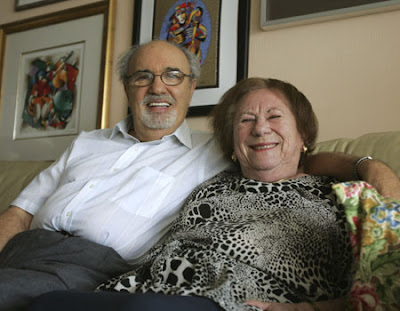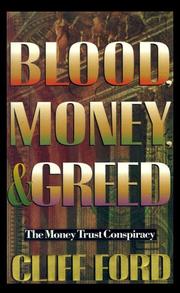 Herman and Roma Rosenblat pose for a photo in their North Miami Beach, Fla. home. Rosenblat's memoir was recently cancelled for release.
Herman and Roma Rosenblat pose for a photo in their North Miami Beach, Fla. home. Rosenblat's memoir was recently cancelled for release.News of Fabricated Holocaust Memoir Sparks Anger, Sadness
Monday, December 29, 2008

NEW YORK — It's the latest story that touched, and betrayed, the world.
"Herman Rosenblat and his wife are the most gentle, loving, beautiful people," literary agent Andrea Hurst said Sunday, anguishing over why she, and so many others, were taken by Rosenblat's story of love born on opposite sides of a barbed-wire fence at a Nazi concentration camp in Germany.
"I question why I never questioned it. I believed it; it was an incredible, hope-filled story."
On Saturday, Berkley Books canceled Rosenblat's memoir, "Angel at the Fence." Rosenblat acknowledged that he and his wife did not meet, as they had said for years, at a sub-camp of Buchenwald, where she allegedly sneaked him apples and bread. The book was supposed to come out in February.
"I wanted to bring happiness to people," said Rosenblat, who now lives in the Miami area. "I brought hope to a lot of people. My motivation was to make good in this world."
Rosenblat's believers included not only his agent and his publisher, but TV talk show host Oprah Winfrey, film producers, journalists, family members and strangers who ignored, or did not know about, the warnings from scholars that his story did not make sense.
Other Holocaust memoirists have devised greater fantasies. Misha Defonseca, author of "Misha: A Memoire of the Holocaust Years," pretended she was a Jewish girl who lived with wolves during the war, when she was actually a non-Jew who lived, without wolves, in Belgium.
Historical records prove Rosenblat was indeed at Buchenwald and other camps.
"How sad that he felt he had to embellish a life of surviving the Holocaust and of being married for half a century," said Holocaust scholar Michael Berenbaum.
The damage is broad. Publishing, the most trusting of industries, has again been burned by a memoir that fact-checking might have prevented. Berkley is an imprint of Penguin Group (USA), which in March pulled Margaret B. Jones' "Love and Consequences" after the author acknowledged she had invented her story of gang life in Los Angeles. Winfrey fell, as she did with James Frey, for a narrative of suffering and redemption better suited for television than for history.
The damage is deep. Scholars and other skeptics as well as fellow survivors fear that Rosenblat's fabrications will only encourage doubts about the Holocaust.
"I am very worried because many of us speak to thousands of students each year," says Sidney Finkel, a longtime friend of Rosenblat's and a fellow survivor. "We go before audiences. We tell them a story and now some people will question what I experienced."
"This was not Holocaust education but miseducation," Ken Waltzer, director of Jewish Studies at Michigan State University, said in a statement.
"Holocaust experience is not heartwarming, it is heart rending. All this shows something about the broad unwillingness in our culture to confront the difficult knowledge of the Holocaust," Waltzer said. "All the more important then to have real memoirs that tell of real experience in the camps."
Among the fooled, at least the partially fooled, was Berenbaum, former director of the United States Holocaust Research Institute at the U.S. Holocaust Memorial Museum in Washington. Berenbaum had been asked to read the manuscript by film producer Harris Salomon, who still plans an adaptation of the book.
Berenbaum's tentative support — "Crazier things have happened," he told The Associated Press last fall — was cited by the publisher as it initially defended the book. Berenbaum now says he saw factual errors, including Rosenblat's description of Theresienstadt, the camp from which he was eventually liberated, but did not think of challenging the love story.
"There's a limit to what I can verify, because I was not there," he says. "I can verify the general historical narrative, but in my research I rely upon the survivors to present the specifics of their existence with integrity. When they don't, they destroy so much and they ruin so much, and that's terrible."
"I was burned," he added. "And I have to read books more skeptically because I was burned."










1 comment:
How awful that the Rosenblats lied about their story and that the publishers and movie makers and Oprah didn’t figure it out. So sad.
Some Holocaust love stories are true. The NY Times featured a story about the famous comic book artists Stan Lee and Neal Adams and a story they were publicizing.
The story is about Dina Gottliebova Babbitt who was a 19 year old art student at Auschwitz. There she was asked by the Jewish head of the children's camp to paint something to cheer them up. Dina painted a mural of Snow White and the Seven Dwarves and in the end, Dina's art became the reason for her salvation.
Painting the mural for the children caused Dina to be taken in front of Dr. Mengele, the Angel of Death. She thought she was going to be gassed, but she bravely stood up to Mengele and he decided to make her his portrait painter, saving herself and her mother from the gas chamber.
After the war, Dina applied for a job to be an animator and the person interviewing her turned out to be the man who created Snow White & the 7 Dwarfs for the movie. They fell in love and got married. Show White saved Dina's life twice!
Post a Comment